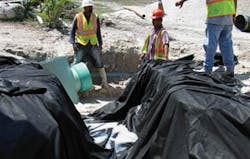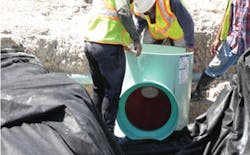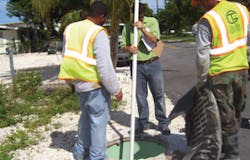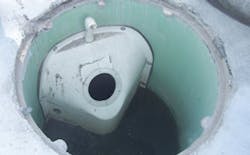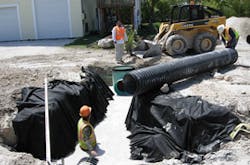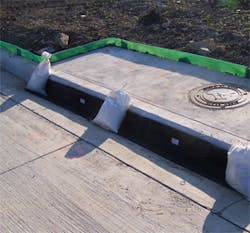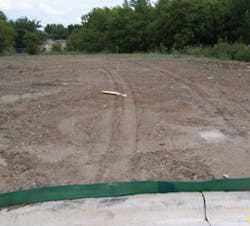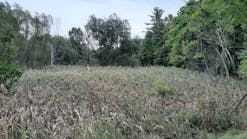Sediment Control During and After Construction
After the National Pollutant Discharge Elimination System (NPDES) Phase II went into effect in 2003, sediment control on construction sites became a priority. Hefty fines can be levied against sites releasing sediment; Phase II applies to construction sites of between 1 and 5 acres, smaller than the 5-acres-and-larger sites covered under Phase I.
Contractors, engineers, and installers around the country are searching for the right mix of products for sediment control on job sites. Many factors come into play: cost, ease of installation and maintenance, durability, and performance.
Some best management practices (BMPs) are used during construction to prevent polluted runoff from leaving a site. Others are more permanent, intended to control post-construction runoff. A multitude of products exist for each application. Examples from around the country may point you in the right direction for your project.
Temporary sediment control products need to be able to handle heavy sediment loads coming from cleared land and heavy truck and foot traffic. Temporary does not mean cheap, but fines for noncompliance during the construction phase can cost much more.
Frank Jackson, project manager of MGS Environmental in Arlington, TX, uses many temporary BMPs during the construction phase of his projects. A recent project in Arlington was a 35-acre residential development called Cinnamon Creek. The area was to be divided into 125 lots with two large public areas. According to Jackson, many developers in Texas have been using erosion control blankets for sediment control. But they are often not used in the proper way, and when they are stepped on, they tear and do not provide effective sediment control.
Texas Storms
For the Cinnamon Creek project, Jackson bought about 8,000 linear feet of Perimeter Guard from ERTEC Environmental Systems of Alameda, CA. “It performed beautifully,” he says. The Perimeter Guard was placed around the entire community and in the areas that would carry truck traffic. Crews also installed Edge Guard in less-traveled areas around the common areas. Curb Inlet Guard was also used. The project subcontractors encouraged their workers to temporarily remove the Edge Guard before driving over them to increase the longevity.
ERTEC makes products for sediment control during construction. These products have a “strong track record of cutting a builder’s costs in half,” says Vince Morris, the company’s president. The initial costs may be higher, but the ease of installation, reduced maintenance, and durability during the life of the project more than make up the difference. As an added benefit, the devices can be reused, providing additional savings.
All ERTEC sediment control devices are derived from similar materials, but shaped and fitted for different purposes. The outer jackets are made from an HDPE polymer matrix, and the devices have an integrated particle filter to retain sediment and debris, while allowing water flow. They are all made to be long lasting and reusable, so a contractor can move them to another job site when the first site is stabilized.
Regarding drain inlet protection, Morris says that any products in this category must balance two concerns: the need to not back up water, which can cause traffic hazards, and the requirement to capture as much sediment as possible. “You can’t do both completely,” he adds, “so it is necessary to balance the two.” For grated inlets, there is the added safety issue of removing heavy grates, which can cause hand and back injuries. ERTEC products can be cleaned without removing the grates.
At the Cinnamon Creek site, installation was fairly simple. Perimeter Guard was trenched into place at the curb about 1.5 inches deep and anchored to the ground. Curb Inlet Guard was placed across the inlet and small gravel bags were used to keep it in place.
Most of the time, the units were cleaned quickly in the field. Sometimes a device would have a heavier load of organic material and sediment. In those cases, Jackson says, the maintenance crews would install fresh units and carry the dirty ones back to the shop for cleaning.
The Dallas-Fort Worth area received several significant rain events during the project, including heavy rain from the remnants of Hurricane Ike. Jackson and his crews watched the installations closely during the storms. “They slowed the flow of water and reduced sediment movement onto the street,” he notes. He also likes that the devices are reusable in contrast to other products that end up in the landfill.
California Homebuilding
In Stockton, CA, Combo Guard from ERTEC was installed at a residential building site to provide filtration of stormwater before runoff flowed into storm drain inlets. The Combo Guard has two sections to fit combination curb and grate inlets. The vertical part is 3 inches high and handles high-flow water conditions, while the horizontal part is anchored with small gravel bags to capture sediment during lower flows.
The alternatives considered for the site were drain inserts, but these products can be difficult to install and maintain because they sit inside the inlet. The grates must be removed for installation and maintenance. Combo Guard can be cleaned in place without removing the grate.
Landscaping New Mexico
Rodger Barton, owner of SWPPP Inc. of Albuquerque, NM, had the chance to work on the largest New Mexico
Installation of the Nyloplast structure
landscaping project in 20 years. The site is the interchange of I-25 and I-40 in central Albuquerque. In 2001, the interchange was rebuilt, and a system of flyovers was added. The project was done in five parts over a number of years; Barton designed the stormwater plan and installed BMPs.
The site covers about 40 acres and includes 250 storm drains, slopes from the highways, and detention ponds. To prevent sediment from the construction from entering the storm drains, wattles were placed around each drain and weighed down with gravel bags.
Crews also placed filters manufactured by Blocksom and Company of Michigan City, IN, around the inlets. These inlet filters are made of coir fibers bonded to a fiberglass mesh. The filters can be ordered in pre-cut sizes or in a roll. Barton says crews used both, and the convenience of a roll of filter that could be cut any size was important in accommodating inlets of odd sizes or places where a heavier sediment load was expected. Most of the filters used were cut 5 feet by 5 feet. Each one was shaped to fit the area, and cable ties were used to secure it on top of the inlet grate.
Placing the SNOUT into the structure
“The installation was pretty simple and short-only 15 to 20 minutes for each one,” Barton says. The inlet grates do not have to be removed to place the filters, adding to the speed and safety of installation.
The truck drivers working at the site preferred the filters that were tied with the cable ties because there were no gravel bags that might be driven over, causing an accident. Barton also says that the filters have a nice clean look on the ground.
He also appreciates that it’s easy to see when they need maintenance.
Probing bottom of structure to measure settleable debris
Typically maintenance involves simply sweeping off the sediment and getting rid of it. Most of the filters did not have a large amount of buildup, even through eight or nine storms of 0.5 inch to 0.75 inch of rain.
Terry Jones, vice president of Geo-Products Inc. based in Pearl, MS, has also used the Blocksom and Company filter products. A large shopping mall project was being built in Jackson, MS. After the dirt work was done, the parking lot was built, including drop inlets.
The contractor was in danger of fines for lack of compliance with stormwater runoff requirements and was facing pressure from the state Department of Environmental Quality to clean up the sediment and trash that was coming from the site. The effluent from the parking lot flowed into a sediment pond.
SNOUT with access hatch open for cleaning
Wattles were considered as a solution, but the contractor wanted something more durable because of the amount of traffic onsite. The general contractor called Geo-Products to figure out a plan, and filters from Blocksom and Company were used.
The filters were placed over the inlet drains in the parking lot. Jones says the installation was simple and the filters were economical. As construction continued, the filters collected sediment and trash from the site. After each rain event, the filters were swept. If a filter was especially full of sediment, it was replaced and then taken back to the shop to be cleaned with a pressure washer. This process only took one individual eyeballing each filter to see what was needed.
Another benefit of the filters was that they could be driven over, so truck drivers do not have to swerve around wattles or bales in the parking lot. The filters were durable enough to withstand the heavy traffic.
Canada Construction
In 2001, construction was occurring in multiple places in Calgary. Loads of sediment washing into streets
Components are lightweight and easy to install.
during heavy rainstorms was causing problems in Springbank Hill and other subdivisions.
Contractors placed the Dandy Curb Bag, manufactured by Dandy Products of Westerville, OH, in front of every curb inlet in the development. The Dandy Curb Bag has two parts; one goes inside the inlet and a cylindrical section is placed against the curb drain. The bright orange color provides visibility and the patented design allows water to flow through while capturing the sediment. Installation or maintenance only requires one person. The bag has dumping straps on the bottom to ease in cleaning. Absorbent pillows can be added in areas of heavy hydrocarbon contamination.
While other products had exacerbated problems in Springbank Hill, leading to release of sediment and flooding, the Dandy Bag performed well. The day after installation, heavy rain events occurred. The system was able to handle the sediment runoff even from the caked-on spots in the streets.
Curb inlet and site perimeter protection on a 35-acre residential development
More permanent devices for post-construction sediment control can also be installed in inlets and catch basins. Factors for choosing permanent BMPs are similar: cost, performance, and ease of installation and maintenance.
A New Stormwater System
The city of Marathon, FL, is installing a citywide stormwater system in seven phases. It is a huge project, incorporating both sanitary sewer and stormwater systems in one trench, eliminating the need for more space for trenches, and reducing traffic interruption.
Mike Giardullo of Weiler Engineering Corporation explains that the stormwater system consists of 1,000 Nyloplast curb inlet structures with SNOUTs attached for filtering the water. Manufactured by Best Management Products Inc. of Middle River, MD, the SNOUT is an insert that captures and separates debris and oil from stormwater runoff. It is a hood constructed of plastic composite that fits over the outlet pipe of a catch basin. Sediment and heavy debris entering the catch basin sink to the bottom, while the SNOUT filters out oil and floating trash. Cleaner water is released to the outlet pipe. An anti-siphon device prevents backwash.
The SNOUT is available in a number of sizes and shapes to fit various catch basin designs. Installation involves placing a gasket on the SNOUT and attaching it to the outlet pipe with stainless steel bolts. The anti-siphon pipe is connected to the SNOUT hood. Maintenance is accomplished during catch basin cleanout by washing with a hose, removing the settled particles with a vacuum truck, and ensuring that the anti-siphon pipe is clear. The maintenance schedule is simplified because there are no screens or filters that would have to be cleaned or replaced frequently. The cycle is set by the depth of the sump and the amount of settleables that come in.
The Nyloplast curb inlets are made of heavy-duty PVC with iron grates. They can be attached to corrugated polyethylene stormwater sewer pipes in sizes ranging from 8 inches to 30 inches in diameter. Being made of PVC, the units are impervious to corrosion. The Nyloplast system is installed, SNOUTs are attached, and backfill is placed; the installation is minimal compared to concrete. The Nyloplast inlets are lightweight enough that there is no need for heavy construction equipment. The combination of Nyloplast pipe and SNOUT unit gives a cost effective, durable stormwater water drainage system.
The Marathon installation is unusual in that the entire system must be installed underwater because of the high water table in the city. The installation of the system has been trouble free and that has saved time over other applications.
Giardullo says that the contractor is responsible for maintenance until the entire system is handed over to the city. Vacuum trucks clean out the sediment on the bottom of the sump and the floatables retained by the SNOUT. Once several cycles of maintenance have been performed, the city will know which locations need maintenance sooner than others.
Retrofitting in South Carolina
The city of Myrtle Beach, SC, recently retrofitted its downtown drainage system along 14th Avenue North. Eric Sanford of DDC Engineers Inc. explains that there had been little stormwater management required and no BMPs built into the area, so the retrofit project was starting from scratch. The receiving water body is the Atlantic Ocean, so water quality is crucial. The 90-acre section has close to a 100% impervious surface, and trash such as cigarette butts and soda cans needs to be captured, as well as oil from roadways.
To handle point source pollution, catch basin inserts with SNOUTs attached were installed. Sanford says that the combination was the most cost-effective solution for the situation. “Installation was easy,” he reports. The city is now handling maintenance of the system using vacuum trucks.
The $13 million project was finished two years ago. Since that time, the area has received several rain events of 2 inches or more and two tropical storms bringing heavy rain. The system has performed well in each case.
Multiple Systems in Colorado
The city of Loveland, CO, has become a test bed for stormwater management devices. Joe Chaplin, stormwater quality specialist for Loveland, says that the city had hoped to fund a study of various stormwater devices by a college, such as nearby Colorado State University. The money for an extensive study was not available; however, when the city started a huge capital improvement program for the downtown area, it installed several different devices and is currently observing the results.
Starting in 2000, replacement of the storm sewer system began. The previous system could only handle half-year storms, and during the rainy season, outflow into the Greeley-Loveland Canal caused problems because irrigation water filled the canal. The plan was to upgrade the storm sewer to handle a 10-year storm.
In the project’s first phase, 750 linear feet of 58-inch storm sewer pipe was laid. Wetlands were created for the stormwater to enter before flowing into the Big Thompson River.
The second phase of the project included laying 2,500 linear feet of storm sewer, installing a sanitary sewer line, and constructing a concrete bike path. Siphon systems had to be built in some locations because of the placement of other utilities. The project’s third phase consisted of installing more storm sewer pipes and laterals from other downtown streets. During all of the phases, curb inlets were installed.
During the construction of this huge project, temporary BMPs were used, including silt fence and straw bales. However, Chaplin says that straw bales are no longer used in Loveland because they are not effective in areas with traffic.
For permanent BMPs, protection and filtration devices were installed, including SNOUTs; stormwater units from Stormceptor, BaySaver Technologies, and CrystalStream Technologies; and Downstream Defender units from Hydro International. Chaplin says that for each unit, the city is comparing cost, ease of installation, and frequency of maintenance. Sweeper inlets were installed along the curbs.
The maintenance schedule so far has been three or four times a year. Some of the devices have deeper inlets and can be serviced twice yearly. Vacuum trucks are used to remove the heavy sediments and the floatable debris.
As with most devices, maintenance is a critical component of the performance of these devices. A filter or bag that is completely clogged with dirt will not work. Devices that capture sediment in a sump have to be cleaned regularly to ensure continued filtration. Whatever system is chosen must be observed to determine the best maintenance schedule.
Reducing the amount of sediment, trash, and other debris in stormwater runoff will continue to be a critical issue for municipalities of all sizes. With the variety of products on the market, a solution for any situation can be found. Finding the right mix depends on the factors important to each location, whether it is cost, performance, durability, or ease of installation and maintenance.
